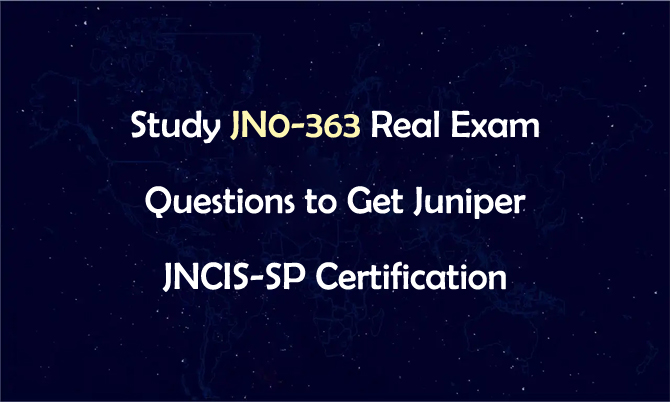According to the latest news from Juniper official website, JN0-362 exam has been retired on June 19, 2022, and the new replacement test is JN0-363 Service Provider Routing and Switching, Specialist (JNCIS-SP). If you are planning to get Juniper JNCIS-SP certification, you need to pass Juniper JN0-363 test. We have cracked the latest Juniper JNCIS-SP certification JN0-363 real exam questions, which are valuable for you to pass the test.

Juniper JNCIS-SP JN0-363 Exam
The Juniper JN0-363 written exam verifies your basic understanding of routing and switching technologies and related platform configuration and troubleshooting skills.
Number of questions: 65 multiple-choice questions
Duration: 90 minutes
Language: English
Test Center: Pearson VUE
Note: Juniper JNCIS-SP certification is valid in 3 years.
JN0-363 Service Provider Routing and Switching, Specialist (JNCIS-SP) Objectives
The following are the details of JN0-363 Service Provider Routing and Switching, Specialist (JNCIS-SP) objectives.
Protocol-Independent Routing
Open Shortest Path First (OSPF)
Intermediate System to Intermediate System (IS-IS)
Border Gateway Protocol (BGP)
Layer 2 Bridging or VLANs
Spanning-Tree Protocols
Multiprotocol Label Switching (MPLS)
IPv6
Tunnels
High Availability
Share Juniper JN0-363 Real Exam Questions
The latest Juniper JN0-363 real exam questions are the best material for you to test the above Service Provider Routing and Switching, Specialist (JNCIS-SP) objectives. Share some Juniper certification JN0-363 real exam questions and answers below.
1. Which two statements are correct about default BGP route propagation? (Choose two.)
A. EBGP speakers advertise IBGP-learned routes to other EBGP peers.
B. EBGP speakers advertise IBGP-learned routes to other EBGP peers by using apolicy.
C. IBGP speakers advertise EBGP-learned routes to other IBGP peers.
D. IBGP speakers advertise IBGP-learned routes to other IBGP peers.
Answer: B,C
2. Which two problems occur when increasing numbers of users are added to an Ethernet LAN with no switches present? (Choose two.)
A. There is a greater chance for collisions to occur
B. The MAC table sizes increase
C. Some devices will not see certain traffic
D. There is unnecessary consumption of network bandwidth
Answer: A,D
3. You want to save adjacency formation time between two routers participating in OSPF, as well as reduce the size of the OSPF link-state database. How would you accomplish these tasks?
A. Define a point-to-point connection.
B. Specify a designated router.
C. Specify a backup designated router.
D. Configure a virtual link.
Answer: A
4. Which forwarding table designation is used to indicate that load balancing is working correctly?
A. msct
B. ucst
C. mlst
D. ulst
Answer: D
5. Router B is an OSPF router connected to both Area 0 and Area 2. Area 2 has been configured as a totally stubby area.Which three LSA types does Router B suppress from Area 2? (Choose Three.)
A. Summary LSA
B. External LSA
C. Router LSA
D. Network LSA
E. ASBR Summary LSA
Answer: A,B,E
